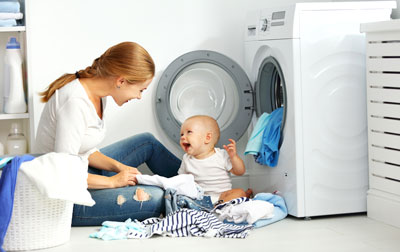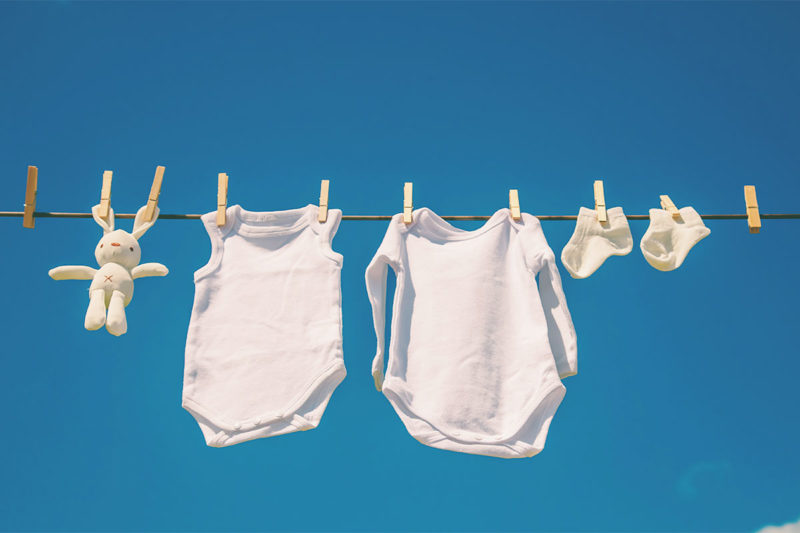Wearing a new garment carries risks. To resist the temptation of putting on that new T-shirt right away, take a look at all the problems you are running into. You’ll soon change your mind!
A new item is not necessarily one that’s harmless, let alone clean. A garment still on a clothes hanger is liable to contain a load of chemicals, which get into its fibres during the production process and freight transport. Not to mention the number of people who tried on this garment before you and left a host of germs and bacteria behind.
Toxic substances in new clothes?
- According to the Transparency Index 2020 by Fashion Revolution, only half of the 250 biggest fashion labels are yet to draw up the list of prohibited substances in their clothes. Yet only a quarter of them have pledged to eliminate them from their supply chain. However, there is the well-known Oeko-Tex Standard 100 certification which guarantees that the garment does not contain any chemicals harmful to human health.
- Here in France, following alarming study findings, ANSES (the national food safety, environmental and occupational health agency) identified some 20 chemicals found in new clothes. They include benzidine, chrome 6, nickel, nonylphenols and formaldehydes. While these toxic agents can cause irritation, allergies and dermatitis, some (like nonylphenols) are known to be endocrine disruptors, reprotoxic and carcinogenic.
- In addition, all these clothes which often circumnavigate the globe before reaching your wardrobe are treated with a host of preservatives to prevent mould developing in damp atmospheres. In addition, anti-crease substances are used to leave them looking at least somewhat presentable after their long journey.
- On top of that comes all the human contact. From the workers who make the garments to those who pack them in cardboard boxes and plastic bags. Not forgetting all the would-be buyers who, drawn to the same garment as you, tried it on before you. Philip Tierno, Professor of Microbiology at New York University, has detected all kinds of bacteria in new clothing, including streptococcus and staphylococcus! He explains that trying on, touching and unfolding a garment, and then putting it back, all leave all these invisible bugs on it via the skin and exhaled air. If you then rub or otherwise touch your eyes, or let your hand brush your mouth or nose, that’s all it takes for the germs to transfer to you as a new host. Beyond irritation, putting on a garment without laundering it first can give you scabies, a fungal infection or lice.
- And don’t go thinking that certification, organic or otherwise, leaves you protected. It tells you that the fibres are organic, but doesn’t provide assurance that the garment hasn’t been treated with substances, like dyes during the production process, or that it has not been handled or tried on.
So you get it by now. You absolutely must launder new garments, however much you like that “new on” look. Fortunately, the ANSES study also showed that laundering once gets rid of toxic substances completely, including nonylphenols. There’s no need for a hot wash at 90° – instead, follow the garment care label instructions.
Safe, environmentally-responsible laundering for new clothes

If the instruction on the care label of a new garment is 30°, that means 30°. This is an effective laundry temperature that’s far better for the planet and your budget. Because every degree counts when it comes to saving energy and reducing global warming. Procter & Gamble is launching an “every degree makes a difference” campaign. The firm has calculated that in Europe, 60% of a laundry detergent’s carbon footprint comes from the laundry temperature selected. Lowering this temperature to 30°-40° cuts CO2 emissions by 35% in the space of a month. This equates to the amount emitted by a city with the population size of Birkenhead, or that saved by taking two million cars off European roads. Note that by lowering the average laundry temperature by 3°, you make an energy saving of 11%. At 60°, you use 1.3 kWh, at 40° around 0.7 kWh, and at 30° your energy usage drops to 0.4 kWh. Let alone that you can put your washing machine on at off-peak times to reduce your bill even further. In addition, laundering at low temperatures is more gentle on your clothes and reduces wear.
If you have time, it’s best to soak your garment overnight in cold water before putting it through the machine. This tightens the fibres and also gets rid of any chemicals.
How should you launder new clothes for infants?

Baby clothes are designed to be machine washed. However, avoid using fabric softener, which can be an irritant. Instead, pour 250 cl of white vinegar into the fabric softener drawer. Don’t worry, the clothes won’t smell like vinegar.







